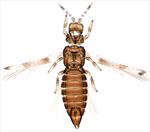
Female

Antenna
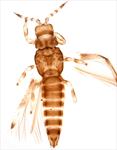
Male
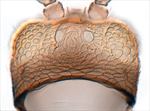
Head

Pronotum
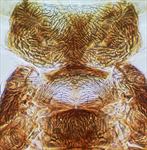
Pronotum, mesonotum & metanotum
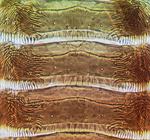
Abdominal tergites
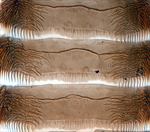
Abdominal tergites

Male sternites

Fore wing
Both sexes fully winged. Body and legs brown, tarsi yellow, also base and apex of tibiae; antennal segments III–V largely yellow; fore wing with base dark followed by a narrow white band, also sub-apically a longer white band, apex dark, but the long median shaded area sometimes slightly paler at mid-point. Antennae 8-segmented, III & IV each with a forked sense cone, VII–VIII elongate. Head and pronotum without prominent setae; head reticulate with markings inside each reticle, pronotal sculpture forming lines with markings between the lines. Metanotum strongly sculptured, median setae wide apart. Metathoracic endofurca lyre-shaped and extending to mesothorax. Fore wing first vein with 2 setae on distal half, second vein with about 6 setae; postero-marginal cilia wavy. Tarsi 1-segmented; hind coxae with internal coiled apodeme. Abdominal tergites II–VIII with median pair of setae small, posterior margin with prominent craspedum that is toothed laterally; lateral thirds of tergites with linear sculpture and markings between these lines anterolaterally on each tergite. Sternites with 3 pairs of marginal setae arising anterior to broad craspedum.
Male sternites III–VII with slender transverse pore plate.
The Panchaetothripinae is a group of about 140 leaf-feeding species in 40 genera found mainly in the tropics and subtropics. The genus Caliothrips currently comprises 23 species, of which 10 are known from North America (Nakahara, 1991), mostly from the southeastern States. Populations of C. phaseoli from South America are sometimes treated as a distinct species, C. braziliensis, because the fore wing is uniformly dark medially, whereas in the North American populations this dark band is paler medially (Nakahara, 1991). Also very similar is C. multistriatus Nakahara from southeastern USA, in which there are wrinkles between all the main sculpture lines on the tergites, and the Caribbean species, C. nanus (Hood) that has a stout dark seta on the fore wing veinal fork.
Breeding on leaves, and recorded from many plants; sometimes reported as a pest on cotton, but probably associated particularly with the leaves of Fabaceae.
Recorded from California, Arizona and Texas, but also Mexico and south to Argentina.
THRIPIDAE - PANCHAETOTHRIPINAE
Caliothrips phaseoli (Hood)
Heliothrips phaseoli Hood, 1912: 113
Heliothrips braziliensis Morgan, 1929: 7
Hercothrips ipomoeae Moulton, 1932: 481
Caliothrips flavescentis De Santis, 1967: 3
Nakahara S (1991) Two new species of Caliothrips (Thysanoptera: Thripidae) and a key to the Nearctic species. Journal of the New York Entomological Society 99: 97–103.